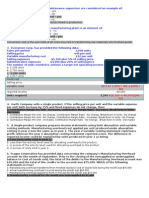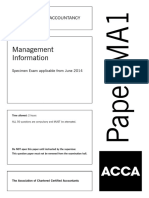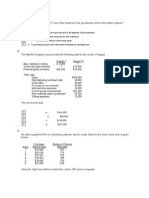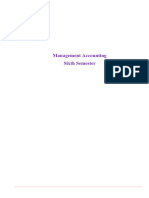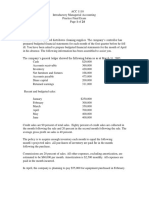Cpa Questions Part X
Cpa Questions Part X
Uploaded by
Angelo MendezCopyright:
Available Formats
Cpa Questions Part X
Cpa Questions Part X
Uploaded by
Angelo MendezOriginal Title
Copyright
Available Formats
Share this document
Did you find this document useful?
Is this content inappropriate?
Copyright:
Available Formats
Cpa Questions Part X
Cpa Questions Part X
Uploaded by
Angelo MendezCopyright:
Available Formats
Business Environment & Concepts 5 Class Questions
1. CPA-03477 A processing department produces joint products Ajac and Bjac, each of which incurs separable production costs after split-off. Information concerning a batch produced at a $60,000 joint cost before split-off follows: Product Ajac Bjac Separable costs $ 8,000 22,000 $30,000 Sales value $ 80,000 40,000 $120,000
What is the joint cost assigned to Ajac if costs are assigned using the relative net realizable value? a. b. c. d. $16,000 $40,000 $48,000 $52,000
CPA-03477 Choice "c" is correct. Using the relative net realizable value method of allocating the joint costs, the net realizable value of both products needs to be calculated: Sales Separable costs Net realizable value Ajac $80,000 (8,000) $72,000 Bjac $40,000 (22,000) $18,000
The joint costs are allocated based on relative net realizable values. The two products together have a net realizable value of $90,000 ($72,000 + $18,000). Ajac contributes 80% of this total (72,000 / $90,000 = 80%). 80% of the joint costs are thus allocated to Ajac: 80% $60,000 = $48,000. Choice "a" is incorrect. This answer uses only the separable costs, not the net realizable value. The sales value must also be taken into consideration. Choice "b" is incorrect. This answer uses only the sales value, not the net realizable value. The separable costs must also be taken into consideration. Choice "d" is incorrect. The net realizable value (sales value less separable costs) must be computed in order to allocate the joint costs using the net realizable value method.
Business Environment & Concepts 5 Class Questions
2. CPA-03584 Mason Company uses a job-order cost system and applies manufacturing overhead to jobs using a predetermined overhead rate based on direct-labor dollars. The rate for the current year is 200 percent of direct-labor dollars. This rate was calculated last December and will be used throughout the current year. Mason had one job, No. 150, in process on August 1 with raw materials costs of $2,000 and direct-labor costs of $3,000. During August, raw materials and direct labor added to jobs were as follows: Raw materials Direct labor No. 150 $ 1,500 No. 151 $4,000 5,000 No. 152 $1,000 2,500
Actual manufacturing overhead for the month of August was $20,000. During the month, Mason completed Job Nos. 150 and 151. For August, manufacturing overhead was: a. b. c. d. Overapplied by $4,000. Underapplied by $7,000. Underapplied by $2,000. Underapplied by $1,000.
CPA-03584 Choice "c" is correct. Since manufacturing overhead is applied on the basis of direct-labor dollars, the total of the direct-labor dollars for August must first be determined: $1,500 + $5,000 + $2,500 = $9,000 Manufacturing overhead is applied at the rate of 200%, so $18,000 was applied for the month of August (200% $9,000 = $18,000). Actual manufacturing overhead for August was $20,000, so manufacturing overhead was underapplied by $2,000 [$20,000 $18,000]. Choice "a" is incorrect. Manufacturing overhead is applied on the basis of direct-labor dollars incurred during the period. If the amount applied is less than the actual amount, then manufacturing overhead is underapplied. Choice "b" is incorrect. Manufacturing overhead is applied on the basis of direct-labor dollars incurred during the period. The total of the direct-labor dollars is $1,500 + $5,000 + $2,500, or $9,000. Choice "d" is incorrect. Manufacturing overhead is applied on the basis of direct-labor dollars incurred during the period. The total of the direct-labor dollars is $1,500 + $5,000 + $2,500, or $9,000.
Business Environment & Concepts 5 Class Questions
3. CPA-03601 Kerner Manufacturing uses a process cost system to manufacture laptop computers. The following information summarizes operations relating to laptop computer model #KJK20 during the quarter ending March 31: Units 100 500 400 200 Direct Materials $ 70,000
Work-in-process inventory, January 1 Started during the quarter Completed during the quarter Work-in-process inventory, March 31 Costs added during the quarter
$750,000
Beginning work-in-process inventory was 50% complete for direct materials. Ending work-in-process inventory was 75% complete for direct materials. What were the equivalent units of production using the FIFO method, with regard to materials for March? a. b. c. d. 450 500 550 600
CPA-03601 Choice "b" is correct. Under the FIFO method, the equivalent units of production is comprised of three parts: the completion of units on hand at the beginning of the period, the units started and completed during the period, and the units partially completed at the end of the period. Applying these principles to the given fact pattern, the total equivalent units of production for the quarter is detemined as follows: Equivalent units for the first quarter: Work in process, beginning (100 units 50% to complete) Units started and completed: Units completed and transferred out Units in beginning inventory Work in process, ending (200 units 75% complete) Equivalent units of production Choices "a", "c", and "d" are incorrect, per the above.
50
400 (100)
300
150 500
Business Environment & Concepts 5 Class Questions
4. CPA-03628 The following information concerns Forming's equivalent units in May 20X1: Beginning work-in-process (50% complete) Units started during May Units completed & transferred Ending work-in-process (80% complete) a. b. c. d. 7,000 9,000 10,000 19,500 Units 2,000 8,000 7,000 2,500
Using the weighted average method, what were Forming's May 20X1 equivalent units?
CPA-03628 Choice "b" is correct. Units completed Ending WIP (2,500 .80) 7,000 2,000 9,000
Choices "a", "c", and "d" are incorrect based on the above explanation.
5. CPA-03655 What is the normal effect on the numbers of cost pools and allocation bases when an activity-based cost (ABC) system replaces a traditional cost system? a. b. c. d. Cost pools No effect Increase No effect Increase Allocation bases No effect No effect Increase Increase
CPA-03655 Choice "d" is correct. Activity-based costing (ABC) tends to increase both the number of cost pools and the number of allocation bases. ABC breaks down a production process into many activities. It then accumulates costs by activity (i.e., cost pools) using an appropriate allocation base for each activity. A traditional cost system would use one cost and one allocation base (i.e., for factory overhead). On the other hand, ABC would designate many activities within the process and allocate costs by activity using a different allocation base for each activity. Choices "a", "b", and "c" are incorrect based on the above explanation.
Business Environment & Concepts 5 Class Questions
6. CPA-03709 Break-even analysis assumes that over the relevant range: a. b. c. d. Unit revenues are nonlinear. Unit variable costs are unchanged. Total costs are unchanged. Total fixed costs are nonlinear.
CPA-03709 Choice "b" is correct. Break-even analysis assumes that all variable costs and revenues are constant on a per unit basis and are linear over a relevant range. Fixed costs in total are constant. Choice "a" is incorrect. Break-even analysis assumes that all variable costs and revenues are constant on a per unit basis and linear over a relevant range. Choice "c" is incorrect. Total costs do change over a relevant range. Break-even analysis assumes that all variable costs and revenues are constant per unit and linear within a relevant range. Choice "d" is incorrect. Total fixed costs are assumed to be constant (representing a linear relationship) over a relevant range.
Business Environment & Concepts 5 Class Questions
7. CPA-03676 At annual sales of $900,000, the Ebo product has the following unit sales price and costs: Sales price Prime cost Manufacturing overhead Variable Fixed Selling & admin. costs Variable Fixed Profit What is Ebo's breakeven point in units? a. b. c. d. 25,000 31,500 37,500 45,000 $20 6 1 7 1 3 18 $2
CPA-03676 Choice "c" is correct. Step 1: Determine how many units were sold to generate the $900,000 in sales shown in the fact pattern: $900,000/$20 per unit = 45,000 units sold Step 2: Determine the total fixed costs: Unit costs: Fixed manufacturing costs Fixed selling and administrative costs Total fixed cost per unit $ 7 $ 3 $10
Total fixed costs = $10 per unit 45,000 units = $450,000 Step 3: Determine the contribution margin per unit: Selling price per unit Prime costs Variable overhead costs Variable selling & administrative costs Contribution margin per unit Step 4:
Breakeven in units = Fixed costs C.M. per unit
$20 (6) (1) (1) $12
450,000 = 37,500 units 12
Choices "a", "b", and "d" are incorrect based on the above explanation.
Business Environment & Concepts 5 Class Questions
8. CPA-03813 The basic difference between a master budget and a flexible budget is that a master budget is: a. Only used before and during the budget period and a flexible budget is only used after the budget period. b. For an entire production facility and a flexible budget is applicable to single departments only. c. Based on one specific level of production and a flexible budget can be prepared for any production level within a relevant range. d. Based on a fixed standard and a flexible budget allows management latitude in meeting goals. CPA-03813 Choice "c" is correct. A master budget is an overall budget, consisting of many smaller budgets, that is based on one specific level of production. A flexible budget is a series of budgets based on different activity levels within the relevant range. Choice "a" is incorrect. The usefulness of master budgets and flexible budgets is not limited to specific periods. Choice "b" is incorrect. The master budget includes the entire company, not just the production facility. The flexible budget can cover many levels of activity, not just one department. Choice "d" is incorrect. Flexible budgets do not allow management latitude in meeting goals, but they do give management the opportunity to compare actual results to the budget for the activity level achieved.
9. CPA-03560 When production levels are expected to increase within a relevant range, and a flexible budget is used, what effect would be anticipated with respect to each of the following costs? Fixed costs per unit Decrease No change No change Decrease Variable costs per unit Decrease No change Decrease No change
a. b. c. d.
CPA-03560 Choice "d" is correct. Within a relevant range, total fixed costs remain constant. Fixed costs per unit therefore decrease as production levels (i.e., the number of units) increase. On the other hand, variable costs per unit remain constant, so total variable costs increase as production levels increase. Choices "a", "b", and "c" are incorrect based on the above explanation.
Business Environment & Concepts 5 Class Questions
10. CPA-03836 The standard direct material cost to produce a unit of Lem is 4 meters of material at $2.50 per meter. During May 1995, 4,200 meters of material costing $10,080 were purchased and used to produce 1,000 units of Lem. What was the material price variance for May 1995? a. b. c. d. $400 favorable. $420 favorable. $80 unfavorable. $480 unfavorable.
CPA-03836 Choice "b" is correct. Material price variance is the difference between actual price and standard price times actual quantity. (AP SP) AQ = Material price variance [($10,080 4,2000) $2.50] 4,200 ($2.40 $2.50) 4,200 = 420 The variance is favorable because the actual cost ($2.40) was less than the standard cost ($2.50). Choice "a" is incorrect. The material price variance equals the difference in prices times the quantity purchased. Choice "c" is incorrect. The total material variance is $80 unfavorable ($10,000 $10,080). This total variance needs to be separated into price and quantity variances. Choice "d" is incorrect. The material price variance equals the difference in prices times the quantity purchased.
Business Environment & Concepts 5 Class Questions
11. CPA-03845 Water Control, Inc. manufactures water pumps and uses a standard cost system. The standard factory overhead costs per water pump are based on direct labor hours and are shown below: Variable overhead (4 hours at $8/hour) Fixed overhead (4 hours at $5*/hour) Total overhead cost per unit $32 20 $52
*Based on a capacity of 100,000 direct labor hours per month. The following additional information is available for the month of November. a. b. c. d. 22,000 pumps were produced although 25,000 had been scheduled for production. 94,000 direct labor hours were worked at a total cost of $940,000. The standard direct labor rate is $9 per hour. The standard direct labor time per unit is four hours. Variable overhead costs were $740,000. Fixed overhead costs were $540,000. $60,000 favorable. $12,000 favorable. $24,000 favorable. $96,000 favorable.
The variable overhead spending variance for November was:
CPA-03845 Choice "b" is correct. $12,000 favorable variable overhead spending variance: Budgeted variable overhead 94,000 DL hrs. $8/hr. Actual variable overhead Favorable variance $752,000 740,000 $ 12,000
Choices "a", "c", and "d" are incorrect based on the above explanation.
Business Environment & Concepts 5 Class Questions
12. CPA-03883 Listed below are selected line items from the Cost of Quality Report for Watson Products for last month. Category Rework Equipment maintenance Product testing Product repair a. b. c. d. $786 $1,154 $1,849 $1,940 Amount $ 725 1,154 786 695
What is Watson's total prevention and appraisal cost for last month?
CPA-03883 Choice "d" is correct. $1,940 total prevention and appraisal cost. Equipment maintenance (prevention) Product testing (appraisal) $1,154 786 $1,940
Rework is an internal failure cost. Product repair (warranty) is an external failure cost. Choices "a", "b", and "c" are incorrect based on the above explanation.
13. CPA-03890 In a quality control program, which of the following is (are) categorized as internal failure costs? I. Rework. II. Responding to customer complaints. III. Statistical quality control procedures. a. b. c. d. I only. II only. III only. I, II, and III.
CPA-03890 Choice "a" is correct. In a quality control program, internal failure costs are incurred because nonconforming products and services are detected prior to being shipped to customers. Examples are rework, scrap, reinspection and retesting. Choice "b" is incorrect. Responding to customer complaints is an external failure cost incurred because products or services failed to conform to requirements after being delivered to customers. Choice "c" is incorrect. Statistical quality control procedures are appraisal costs incurred to detect defects. Choice "d" is incorrect. Responding to customer complaints is an external failure cost. Statistical quality control procedures are prevention costs.
10
You might also like
- Practical Earned Value Analysis: 25 Project Indicators from 5 MeasurementsFrom EverandPractical Earned Value Analysis: 25 Project Indicators from 5 MeasurementsNo ratings yet
- Acc312 Platt Spr07 Exam1 Solution PostedNo ratings yetAcc312 Platt Spr07 Exam1 Solution Posted13 pages
- Attempt-1: The Company's Accountant Used A Denominator of Budgeted Machine Hours For The Current Accounting Period100% (2)Attempt-1: The Company's Accountant Used A Denominator of Budgeted Machine Hours For The Current Accounting Period18 pages
- ACG 2071 Exam 3 Practice Test With SolutionsNo ratings yetACG 2071 Exam 3 Practice Test With Solutions22 pages
- Chapter 2 Activity Based Costing: 1. ObjectivesNo ratings yetChapter 2 Activity Based Costing: 1. Objectives13 pages
- Complete Download of Introduction to Managerial Accounting Canadian Canadian 4th Edition Brewer Test Bank Full Chapters in PDF DOCX100% (2)Complete Download of Introduction to Managerial Accounting Canadian Canadian 4th Edition Brewer Test Bank Full Chapters in PDF DOCX42 pages
- D. A Period Cost Under Variable CostingNo ratings yetD. A Period Cost Under Variable Costing14 pages
- MG FNSACC517 Provide Management Accounting InformationNo ratings yetMG FNSACC517 Provide Management Accounting Information11 pages
- The 123s of ABC in SAP: Using SAP R/3 to Support Activity-Based CostingFrom EverandThe 123s of ABC in SAP: Using SAP R/3 to Support Activity-Based CostingNo ratings yet
- The Entrepreneur’S Dictionary of Business and Financial TermsFrom EverandThe Entrepreneur’S Dictionary of Business and Financial TermsNo ratings yet
- Maf451 Test 2 Question Odl June 2021 Latest100% (1)Maf451 Test 2 Question Odl June 2021 Latest4 pages
- Business Strat Analysis - Costs Concepts and ClassificationsNo ratings yetBusiness Strat Analysis - Costs Concepts and Classifications37 pages
- ACC 2403 M K: Y U Sy Syms School of Business E I (V B)No ratings yetACC 2403 M K: Y U Sy Syms School of Business E I (V B)9 pages
- 15.963 Management Accounting and Control: Mit OpencoursewareNo ratings yet15.963 Management Accounting and Control: Mit Opencourseware19 pages
- Nature and Scope of Cost Accounting - Dynamic Tutorials and Services0% (1)Nature and Scope of Cost Accounting - Dynamic Tutorials and Services9 pages
- Solutions To All Assigned Practice Problems (W502)No ratings yetSolutions To All Assigned Practice Problems (W502)27 pages
- Research Proposal-CONTRIBUTION OF ACCOUNTING INFORMATION SYSTEM IN DECISION MAKING100% (1)Research Proposal-CONTRIBUTION OF ACCOUNTING INFORMATION SYSTEM IN DECISION MAKING19 pages
- Introduction To Managerial Accounting and Cost ConceptsNo ratings yetIntroduction To Managerial Accounting and Cost Concepts67 pages
- Practical Earned Value Analysis: 25 Project Indicators from 5 MeasurementsFrom EverandPractical Earned Value Analysis: 25 Project Indicators from 5 Measurements
- Attempt-1: The Company's Accountant Used A Denominator of Budgeted Machine Hours For The Current Accounting PeriodAttempt-1: The Company's Accountant Used A Denominator of Budgeted Machine Hours For The Current Accounting Period
- Complete Download of Introduction to Managerial Accounting Canadian Canadian 4th Edition Brewer Test Bank Full Chapters in PDF DOCXComplete Download of Introduction to Managerial Accounting Canadian Canadian 4th Edition Brewer Test Bank Full Chapters in PDF DOCX
- MG FNSACC517 Provide Management Accounting InformationMG FNSACC517 Provide Management Accounting Information
- Advanced Cost Accounting: University TextbookFrom EverandAdvanced Cost Accounting: University Textbook
- Activity Based Costing for Construction CompaniesFrom EverandActivity Based Costing for Construction Companies
- The 123s of ABC in SAP: Using SAP R/3 to Support Activity-Based CostingFrom EverandThe 123s of ABC in SAP: Using SAP R/3 to Support Activity-Based Costing
- The Entrepreneur’S Dictionary of Business and Financial TermsFrom EverandThe Entrepreneur’S Dictionary of Business and Financial Terms
- Business Strat Analysis - Costs Concepts and ClassificationsBusiness Strat Analysis - Costs Concepts and Classifications
- ACC 2403 M K: Y U Sy Syms School of Business E I (V B)ACC 2403 M K: Y U Sy Syms School of Business E I (V B)
- 15.963 Management Accounting and Control: Mit Opencourseware15.963 Management Accounting and Control: Mit Opencourseware
- Nature and Scope of Cost Accounting - Dynamic Tutorials and ServicesNature and Scope of Cost Accounting - Dynamic Tutorials and Services
- Solutions To All Assigned Practice Problems (W502)Solutions To All Assigned Practice Problems (W502)
- Research Proposal-CONTRIBUTION OF ACCOUNTING INFORMATION SYSTEM IN DECISION MAKINGResearch Proposal-CONTRIBUTION OF ACCOUNTING INFORMATION SYSTEM IN DECISION MAKING
- Introduction To Managerial Accounting and Cost ConceptsIntroduction To Managerial Accounting and Cost Concepts







